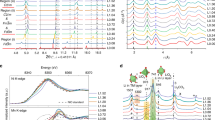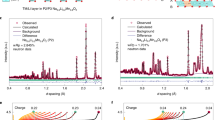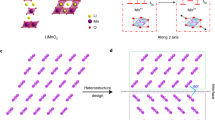Abstract
The increasing demand for portable electronic devices is driving the development of compact lightweight batteries of high energy density1. Lithium-ion batteries tend to be the systems of choice, as they offer higher energy densities and longer operational lifetimes than other rechargeable battery systems1,2. But commercially available lithium-ion batteries make use of layered LiCoO2 cathodes3,4, and the high cost and toxicity of cobalt therefore motivate the development of cheaper and environmentally benign cathode materials. In this regard, manganese oxides are attractive alternatives, and the spinel LiMn2O4 has been investigated intensively as a cathode5,6; however, the fading on cycling of its energy-storage capacity poses problems. More recently, attention has been focused on the synthesis of layered LiMnO2 as a cathode material, but its cycling characteristics remain to be established7,8,9. Here we report the synthesis and electrochemical performance of a new manganese oxide cathode, the oxyiodide Li1.5Na0.5MnO2.85I0.12. Our material exhibits a high reversible capacity of 260 mA h g−1 in the range 1.5–4.3 V with excellent cycling characteristics. Furthermore, the amorphous nature of the material (as determined by X-ray diffraction) and smooth discharge behaviour may help to overcome the problems associated with lattice distortions that have plagued manganese oxides with more crystalline structures5,6,7,8,9
This is a preview of subscription content, access via your institution
Access options
Subscribe to this journal
Receive 51 print issues and online access
$199.00 per year
only $3.90 per issue
Buy this article
- Purchase on Springer Link
- Instant access to full article PDF
Prices may be subject to local taxes which are calculated during checkout




Similar content being viewed by others
References
Scrosati, B. Challenge of portable power. Nature 373, 557–558 (1995).
Oyama, N., Tatsuma, T., Sato, T. & Sotomura, T. Dimercaptan–polyaniline composite electrodes for lithium batteries with high energy density. Nature 373, 598–600 (1995).
Nagaura, T. & Tozawa, K. Lithium ion rechargeable battery. Prog. Batteries Sol. Cells 9, 209–217 (1990).
Scrosati, B. Lithium rocking chair batteries: An old concept? J. Electrochem. Soc. 139, 2776–2781 (1992).
Thackeray, M. M., David, W. I. F., Bruce, P. G. & Goodenough, J. B. Lithium insertion into manganese spinels. Mater. Res. Bull. 18, 461–472 (1983).
Tarascon, J.-M. et al. Synthesis conditions and oxygen stoichiometry effects on Li insertion into the spinel LiMn2O4. J. Electrochem. Soc. 141, 1421–1431 (1994).
Thackeray, M. M. Structural considerations of layered and spinel lithiated oxides for lithium ion batteries. J. Electrochem. Soc. 142, 2558–2563 (1995).
Leroux, F., Guyomard, D. & Piffard, Y. The 2D rancieite-type manganic acid and its alkali exchanged derivatives: Part II—electrochemical behavior. Solid State Ionics 80, 307–316 (1995).
Bruce, P. G. & Armstrong, A. R. Synthesis of layered LiMnO2 as an electrode for rechargeable lithium batteries. Nature 381, 499–500 (1996).
Stein, A., Keller, S. W. & Mallouk, T. E. Turning down the heat: Design and mechanism in solid state synthesis. Science 259, 1558–1564 (1993).
Manthiram, A., Dananjay, A. & Zhu, Y. T. New route to reduced transition metal oxides. Chem. Mater. 6, 1601–1602 (1994).
Tsang, C. & Manthiram, A. Synthesis of nanocrystalline VO2 and its electrochemical behavior in lithium batteries. J. Electrochem. Soc. 144, 520–524 (1997).
Manthiram, A. & Tsang, C. Synthesis of amorphous MoO2+δ and its electrode performance in lithium batteries. J. Electrochem. Soc. 143, L143–L145 (1996).
Vogel, A. I. A Textbook of Quantitative Inorganic Analysis, 348–349 (Longmans, London, (1955)).
Tsang, C. & Manthiram, A. Anew route for the synthesis of LiMn2O4 cathode: Variation of composition, microstructure and electrochemical behavior with synthesis temperature. Solid State Ionics 89, 305–312 (1996).
Sato, K., Noguchi, M., Demachi, A., Oki, N. & Endo, M. Amechanism of lithium storage in disordered carbon. Science 264, 556–558 (1994).
Linden, D. (ed.) Handbook of Batteries, 2nd edn, 36.10 (McGraw-Hill, New York, (1995)).
Li, W. & Currie, J. Morphology effects on the electrochemical performance of LiNi1− x Co x O2. J. Electrochem. Soc. 144, 2773–2779 (1997).
Ohzuku, T. Electrochemistry of manganese dioxide in lithium nonaqueous cell. J. Electrochem. Soc. 137, 40–46 (1990).
Acknowledgements
This research was supported by the National Science Foundation.
Author information
Authors and Affiliations
Corresponding author
Rights and permissions
About this article
Cite this article
Kim, J., Manthiram, A. A manganese oxyiodide cathode for rechargeable lithium batteries. Nature 390, 265–267 (1997). https://doi.org/10.1038/36812
Received:
Accepted:
Issue Date:
DOI: https://doi.org/10.1038/36812
This article is cited by
-
Efficient direct repairing of lithium- and manganese-rich cathodes by concentrated solar radiation
Nature Communications (2024)
-
A novel synthesis strategy to improve cycle stability of LiNi0.8Mn0.1Co0.1O2 at high cut-off voltages through core-shell structuring
Nano Research (2019)
-
Approaching the capacity limit of lithium cobalt oxide in lithium ion batteries via lanthanum and aluminium doping
Nature Energy (2018)
-
Reversible Mn2+/Mn4+ double redox in lithium-excess cathode materials
Nature (2018)
-
The multiple effects of Al-doping on the structure and electrochemical performance of LiNi0.5Mn0.5O2 as cathode material at high voltage
Ionics (2018)
Comments
By submitting a comment you agree to abide by our Terms and Community Guidelines. If you find something abusive or that does not comply with our terms or guidelines please flag it as inappropriate.



